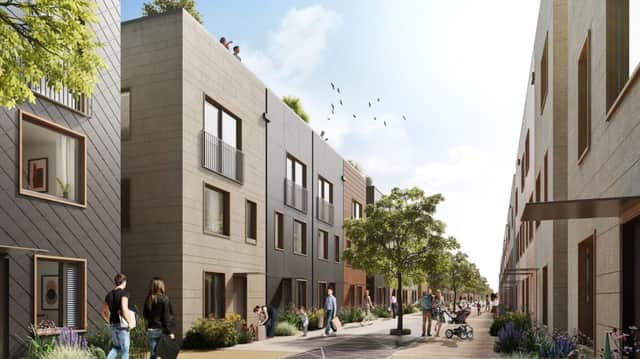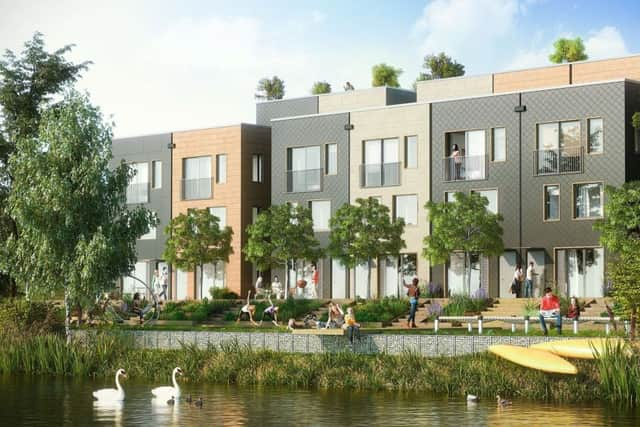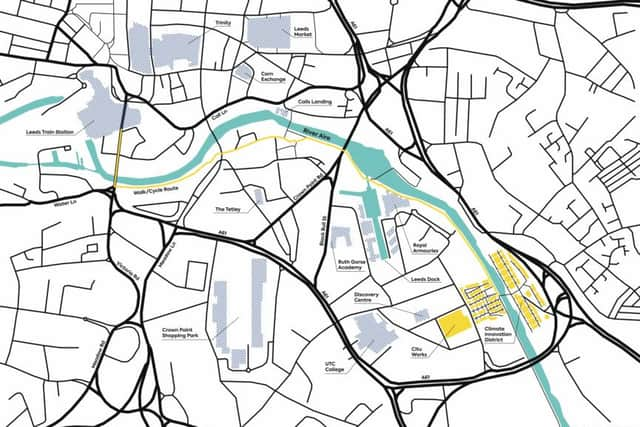Pioneering eco-homes launched for sale at Citu's Leeds South Bank site


With an aversion to what he refers to as “Noddy houses”, Chris Thompson has always shunned a conventional approach to property development. He is an explorer who enjoys bold, innovative ventures in unlikely locations.
His company, Citu, embarked on its first big project in 2004 when he was just 26 years old. He and his young co-directors produced Greenhouse. The block of contemporary apartments and offices in Beeston, South Leeds, was the first to use ground source heat pumps, solar panels and rainwater recycling.
Advertisement
Hide AdAdvertisement
Hide AdNext came Little Kelham in Sheffield, which has revitalised a former industrial site and turned it into a fashionable neighbourhood with 241 contemporary low carbon homes.


The latest and most ambitious scheme is the £125m Climate Innovation District at Leeds South Bank, on the edge of the city centre. Set to be the largest sustainable development in the UK, it will include 515 eco-friendly homes, offices, leisure facilities and a pioneering home-building factory. The first 18 houses and apartments have just been released for sale. The three and four-bedroom homes range from £330,000 to £390,000 and will be ready to move into early next year.
When complete, the development will feature two apartment blocks, “The Hive” and “The Honeycomb”, situated either side of the River Aire, along with a range of riverside houses named “Wind in the Willows”. These waterfront homes, constructed on top of an underground car park, will overlook “The Secret Garden”- more than one square kilometre of open amenity land. Running through the heart of the development will be an urban promenade, “Solar Avenue”, which will feature a timber-decked walkway with access to a shared central green, designed to help foster a sense of community.
Chris spotted the development opportunity during the recession when he bought a parcel of brownfield land by the river close to Leeds Dock. It was owned by a company backed by another entrepreneur, Sir Philip Green, that had been forced into liquidation by the property slump. The Arcadia boss’s loss was Citu’s gain and it quietly began buying surrounding plots to create a 15-acre site. “It has a fantastic river frontage, so it’s an amazing spot and I knew that if we could connect to the city centre and Leeds Dock it would be incredible,” says Chris.
Advertisement
Hide AdAdvertisement
Hide AdPlanning officials welcomed the idea of turning former industrial land into much-needed housing, along with a bridge across the river. The properties herald a fresh approach to both construction and design and are billed as ”A combination of German efficiency, Scandinavian design and good old northern grit.”


Toyota and its “lean thinking” principles, which revolutionised the automotive industry with faster processes, better quality and less waste, was also an influencer.
“We looked at design and delivery models in the automotive industry and we also spent a lot of time visiting housing schemes in Stockholm and Copenhagen, where constructing off-site has been the norm for the past 30 years. It persuaded us to take what is a big, bold step,” says Chris.
The new factory, Citu Works, will make the components for Citu Homes, including the timber frames, roofs, floors and insulated walls with rainscreen cladding and windows already fitted.
Advertisement
Hide AdAdvertisement
Hide AdOnce on site, the shell can be erected in two days leaving an eight-strong assembly squad to fit out the interiors within 12 weeks.


“We don’t make modular homes as they can be difficult to transport. We make components that can be easily transported and quickly erected. We are using an assembly model as opposed to traditional building sites, which rely on hiring tradespeople who work in isolation and are hampered by the weather. In terms of productivity the old method is about 40 per cent efficient. Ours will be 85 per cent efficient as we will reduce production times and costs,” says Chris, who says that industrialising the process will enable Citu to make 750 homes each year.
The properties are based on Scandinavian concepts and Citu worked with a Swedish architect, White Arkitekter, along with Manchester-based Ollier Smurthwaite to design them. The timber-framed housing system followed years of research by Leeds Beckett University.
The homes feature green roofs, triple-glazed windows and air tightness based on German Passivhaus principles. High energy efficiency, solar panels and mechanical ventilation and heat recovery systems mean the properties will be cheap to run.
Advertisement
Hide AdAdvertisement
Hide AdEach resident will become a member of a Community Interest Company, which will take over when the development is fully sold. The CIC will own the landscape, infrastructure and renewable energy systems within the development. All energy produced from the solar panels will enter a community network and the CIC will buy electricity from the National Grid through Good Energy to supplement it. The CIC will then bill each residence according to its energy usage, with excess energy sold back to the grid and the profits used to invest back into the CIC.


“The purpose of all this is to help the drive towards zero carbon cities. The Climate Innovation District will be ann exemplar model,” says Chris, who is also keen to increase diversity. Most city centre schemes in the regions are apartments populated by young professionals with a sprinkling of downsizers. The Climate Innovation District will have a 50/50 split of houses and apartments with between one and four bedrooms.
“Building a mixed community is really important and we envisage a population of young people, families and downsizers. They will be attracted by the natural assets of the river and the canal towpath and by the proximity to the city centre and to the cafes and restaurants at Leeds Dock,” says Chris, who is relocating the Citu HQ from Greenhouse to the Leeds South Bank site.
He believes that the development will be complete within five years thanks to the housing shortage and increasing urbanisation, so he is already looking at more sites with an ambition to to “keep improving our product and keep innovating”.
Advertisement
Hide AdAdvertisement
Hide Ad* The first 18 homes at Citu’s Climate Innovation District include three different property types. The most expensive is by the riverside and costs £380,000. It has four bedrooms and two bathrooms. The other two designs, ranging from £345,000 to £330,000, have four bedrooms, two bathrooms and a roof terrace. Every home comes with parking. Those interested in buying can register for a My Citu account at www.citu.co.uk to receive news and offers. Members also have the chance to put down a refundable deposit of £1,500 to join Citu 52 – an exclusive waiting list, which will include first priority on plots and prices when each phase of homes is released.